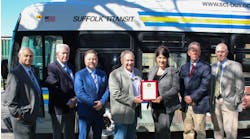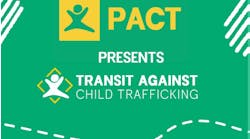Six lives have been saved with NJ (New Jersey) TRANSIT automated external defibrillators (AEDs) since August 2006, when the transit organization began placing AEDs in its train stations, bus terminals and employee facilities.
In December 2006, a NJ TRANSIT employee was revived by two co-workers who had received AED/CPR training just days before. Within the past year, NJ TRANSIT police officers revived a man found unconscious aboard a train stopped at a station, and saved a woman who collapsed at a train station.
These life saves are the fruits of a program that includes AEDs installed at passenger and employee facilities and additional units in NJ TRANSIT police vehicles. Covering a service area of 5,325 square miles, NJ TRANSIT is the nation's third largest provider of bus, rail and light rail transit, linking major points in New Jersey, New York and Philadelphia and providing some 254 million passenger trips each year.
More than 2,000 NJ TRANSIT employees have received AED/CPR training and certification, according to Frank Fittipoldi, NJ TRANSIT's director of Organizational Services. Trained and certified staff are stationed at all locations where AEDs are present, he adds. Since the program was implemented, "the results have been nothing but positive," Fittipoldi states, adding that having AEDs achieves "one of our core mission objectives . . . the safety of our customers."
Helping NJ TRANSIT to plan and implement its AED program was LifeSavers, Inc., a New Jersey company that provides emergency medical response products and services to both public- and private-sector organizations. A key aspect of program planning is determining where exactly to place the AEDs, says Bob Stickel, LifeSavers' president. "Basically, you want to deploy them where the most people are located, such as in a train or bus terminal, and where there may be a delay in EMS response time," for example, in an outlying work area or rural station a good distance away from a fire/EMS house.
Myths About AEDs, CPR and Sudden Cardiac Arrest Uncovered
AEDs revive victims of sudden cardiac arrest, which afflicts about 400,000 Americans each year and is among the major causes of deaths in the United States. Despite the toll this disorder takes, many myths still exist about it.
Myth 1: Sudden cardiac arrest is the same as a heart attack. Truth: They are different conditions and must be treated differently. Sudden cardiac arrest is an arrhythmia or irregular heartbeat, an "electrical" disorder, and a heart attack is caused by a blocked artery, a "plumbing" disorder.
Myth 2: You can save a sudden cardiac arrest victim with CPR alone. Truth: Only an AED can deliver defibrillating shocks that "reboot" the heart's irregular beat and return it to normal. CPR alone cannot revive a sudden cardiac arrest victim; it can only buy time until a defibrillator delivers a lifesaving shock.
Myth 3: An AED isn't needed in mass transit — just call EMS. Truth: An AED victim must be revived as quickly as possible – within seconds to no longer than five minutes – for the best chance of survival, and EMS usually takes longer to arrive at the scene. According to a USA Today investigative report, EMS responders usually take from six to 12 minutes to treat a sudden cardiac arrest victim. Most untreated sudden cardiac arrest victims die within 10 minutes.
AEDs Protect Mass Transit Organizations From Legal Liability
At Boston's North mass transit station, three bystanders saved the life of a man who had suffered sudden cardiac arrest. They used an AED to revive the victim, one of the AEDs present at this and other Massachusetts Bay Transportation Authority (MBTA) stations as a result of a lawsuit brought upon by the widow of a man who had died years earlier on the MBTA system, according to Boston area news reports. She settled her lawsuit after the MBTA agreed to improve its emergency procedures and deploy AEDs. Subsequently, the MBTA has deployed more than 100 AEDs.
Because AEDs are becoming more commonplace on mass transit systems and in other public areas, a court may view AED availability as a "standard of care" should a lawsuit be filed after an AED is unavailable during a sudden cardiac arrest episode. In addition, Good Samaritan laws passed in many states protect rescuers and organizations providing AEDs from legal liability if an AED fails for some reason to resuscitate a victim. There has never been a successful lawsuit made against a person or organization using an AED in good faith.
The "standard of care" concept that courts consider in cases of alleged negligence should not be taken lightly. Standard of care measures a community's expectations of what an organization should reasonably provide to customers or workers. To determine standard of care, a judge or jury looks at industry norms and trends and compares them to the case before the court.
For example, dozens of lives have been saved by AEDs in America's airports, which virtually all have AEDs. With defibrillators increasingly available in airports and other transportation hubs, having an AED available on a mass transit system can easily be ruled a standard of care. Therefore, a mass transit system places itself in potential legal jeopardy by not having an AED program – it is more susceptible to legal damages if an AED program is not in place.
The Challenges of Deploying AEDs on a Mass Transit System
Mass transit organizations must not deploy AEDs casually, though, as they will be held responsible for sufficiently implementing and maintaining the program to assure the AEDs are kept in good working order. In addition, in this age of tight public-sector budgets, mass transit organizations should purchase affordable, easy-to-use AEDs priced below $1,500 each.
These AEDs will help to stretch dollars, allow the organization to deploy a higher number of AEDs, and increase the chances of successful life saves.
Meeting state and local requirements. A mass transit AED program must be planned and implemented in accordance with any state and local requirements relating to AED placement, AED/CPR training and certification, program medical supervision, and registration with local EMS, Stickel says. "A mass transit organization should have a dedicated AED program coordinator who is familiar with all requirements and that makes sure the organization meets them," he explains. The coordinator should also oversee the day-to-day aspects of the AED program, including AED maintenance, recertification of staff, and review of any rescue episodes, he adds.
Affordability. While the average price of an AED has become more affordable, the price tag for an entire transit system can be intimidating. Mass transit systems should look for AEDs that are affordable and durable, as well as ones that will not become obsolete.
"Everyone's looking to get a quality unit at the lowest cost," Stickel says. The state of New Jersey used the buying power of its cooperative purchasing program to allow NJ TRANSIT and fire, police and other state and local entities to buy in bulk and significantly reduce the cost per AED. The state originally purchased 1,700 AEDs including those for NJ TRANSIT in 2006. To date, more than 6,500 AEDs have been purchased through the cooperative agreement with LifeSavers, Inc., he states.
Preventive maintenance
Mass transit systems should take maintenance factors into account when choosing AED products and services. Many if not most AED failures can be traced to poor maintenance. AEDs are powered by long-life batteries that need to be checked and replaced from time to time. Also, American Heart Association (AHA) guidelines relating to the proper way to use an AED and perform CPR are evolving as new knowledge about resuscitation is discovered, and an AED's audio and video instructional prompts must match these guidelines.
For example, previous AHA guidelines directed rescuers to provide one and a half to three minutes of CPR before using an AED. "The AHA now recommends 'shock first' rather than CPR because 'speed to shock' saves lives – about 90 percent of those who receive shocks within the first few minutes after cardiac arrest survive," Stickel states. The most recent AHA guidelines also emphasize the importance of chest compressions at a rate of 100 a minute, he adds. This "hands-only" method of providing CPR was recommended after medical studies demonstrated that fast, two-inch deep chest compressions to adult victims are associated with survival with good neurologic function.
Software updates provided by some AED manufacturers can be installed in the field to make the AED's audio and video prompts consistent with the latest guidelines. For example, NJ TRANSIT's staffers were able to upgrade their AED software on their own when new AHA guidelines were issued in 2010, Fittipoldi says. NJ TRANSIT's technologically advanced AEDs perform automatic self-checks, with an indicator light showing the AED is in working order. Staff members regularly monitor each AED's indicator light, as well as the condition of the battery, defibrillation pads, and other supplies to make sure they are replaced on time. Once a year, an authorized service dealer inspects and certifies all NJ TRANSIT AEDs, he adds.
A carefully managed maintenance program, including simple, regular checks and more comprehensive annual checks, demonstrates that those responsible for the AEDs are doing everything possible to have the AEDs ready to operate in an emergency. "This is an extremely important aspect of an AED program," Stickel emphasizes.
User Confidence
Studies have found that many people still lack the confidence to use an AED during an emergency. For example, according to the "Public Access Defibrillation: Time to Access the Public" study published in the Annals of Emergency Medicine in 2011, less than half (47 percent) of more than 1,000 travelers and visitors to the Central Railway Station of Amsterdam expressed a willingness to use an AED, and more than half (53 percent) were unable to recognize an AED.
Most AEDs have audio capabilities to cue responders during an emergency event. A study by Defibtech and Harris Interactive found that adding text and video to an AED's audio instructions dramatically improved a user's confidence during an emergency. Video also can enhance AED/CPR training by providing trainees with opportunities to practice and gain confidence in advance of an emergency event.
Take Steps Now to Save a Life
The life saves on NJ TRANSIT and MBTA didn't just happen. They occurred because those responsible for passenger and employee safety chose to be ready. They took proactive steps that turned unfortunate events into celebrations. They saw that mass transit systems serving thousands of people each day should meet the same standard of care as airports.
Virtually all mass transit systems are facing tough budget circumstances. Those whose lives were saved can thank leaders who made the deployment of AEDs a priority and found a way to make it work financially.
With a little old-fashioned initiative, you can do the same. And someday, someone saved by an AED may thank you for it.
Greg Slusser is a vice president for Defibtech, the designer and manufacturer of the Lifeline™ and ReviveR™ families of AEDs and related accessories, www.defibtech.com, 1-866-DEFIB-4-U (1-866-333-4248).


